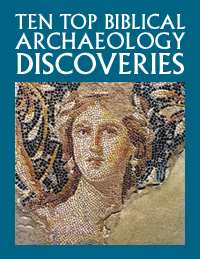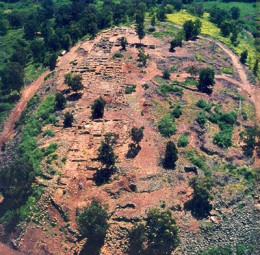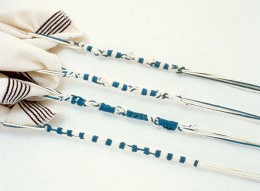For the first time, the royal seal of King Hezekiah in the Bible has been found in an archaeological excavation. The post King Hezekiah in the Bible: Royal Seal of Hezekiah Comes to Light appeared first on Biblical Archaeology...

HEZEKIAH IN THE BIBLE. The royal seal of Hezekiah, king of Judah, was discovered in the Ophel excavations under the direction of archaeologist Eilat Mazar. Photo: Courtesy of Dr. Eilat Mazar; photo by Ouria Tadmor.
The royal seal of King Hezekiah in the Bible was found in an archaeological excavation. The stamped clay seal, also known as a bulla, was discovered in the Ophel excavations led by Dr. Eilat Mazar at the foot of the southern wall of the Temple Mount in Jerusalem. The discovery was announced in a press release by the Hebrew University of Jerusalem’s Institute of Archaeology, under whose auspices the excavations were conducted.
The bulla, which measures just over a centimeter in diameter, bears a seal impression depicting a two-winged sun disk flanked by ankh symbols and containing a Hebrew inscription that reads “Belonging to Hezekiah, (son of) Ahaz, king of Judah.” The bulla was discovered along with 33 other stamped bullae during wet-sifting of dirt from a refuse dump located next to a 10th-century B.C.E. royal building in the Ophel.
In the ancient Near East, clay bullae were used to secure the strings tied around rolled-up documents. The bullae were made by pressing a seal onto a wet lump of clay. The stamped bulla served as both a signature and as a means of ensuring the authenticity of the documents.

FREE ebook: Ten Top Biblical Archaeology Discoveries. Finds like the Pool of Siloam in Israel, where the Gospel of John says Jesus miraculously restored sight to a blind man.
Who Was King Hezekiah in the Bible?
King Hezekiah in the Bible, son and successor of Ahaz and the 13th king of Judah (reigning c. 715–686 B.C.E.), was known for his religious reforms and attempts to gain independence from the Assyrians.

The Ophel excavation area at the foot of the southern wall of the Temple Mount in Jerusalem. Photo: Andrew Shiva.
In Aspects of Monotheism: How God Is One (Biblical Archaeology Society, 1997), Biblical scholar P. Kyle McCarter, Jr., summarizes Hezekiah’s religious reforms:
According to 2 Chronicles 29–32, Hezekiah began his reform in the first year of his reign; motivated by the belief that the ancient religion was not being practiced scrupulously, he ordered that the Temple of Yahweh be repaired and cleansed of niddâ (impurity). After celebrating a truly national Passover for the first time since the reign of Solomon (2 Chronicles 30:26), Hezekiah’s officials went into the countryside and dismantled the local shrines or “high places” (bamot) along with their altars, “standing stones” (masseboth) and “sacred poles” (’aásűeµrîm). The account of Hezekiah’s reform activities in 2 Kings 18:1–8 is much briefer. Although he is credited with removing the high places, the major reform is credited to Josiah (2 Kings 22:3–23:25).
Hezekiah’s attempts to save Jerusalem from Assyrian king Sennacherib’s invasion in 701 B.C.E. are chronicled in both the Bible and in Assyrian accounts. According to the Bible, Hezekiah, anticipating the attack, fortified and expanded the city’s walls and built a tunnel, known today as Hezekiah’s Tunnel, to ensure that the besieged city could still receive water (2 Chronicles 32:2–4; 2 Kings 20:20).

The Sennacherib Prism on display in the Israel Museum in Jerusalem. Photo: Hanay’s image is licensed under CC BY-SA 3.0/ Wikimedia Commons.
On the six-sided clay prism called the Sennacherib Prism as well as other annals of the Assyrian king, Sennacherib details in Akkadian his successful campaigns throughout Judah, bragging that he had Hezekiah trapped in Jerusalem “like a bird in a cage.” According to the Bible, however, Sennacherib ultimately failed to capture Jerusalem before his death (2 Kings 19:35–37).
The bulla discovered in the Ophel excavations represents the first time the royal seal of King Hezekiah has been found on an archaeological project.
“Although seal impressions bearing King Hezekiah’s name have already been known from the antiquities market since the middle of the 1990s—some with a winged scarab (dung beetle) symbol and others with a winged sun—this is the first time that a seal impression of an Israelite or Judean king has ever come to light in a scientific archaeological excavation,” Eilat Mazar said in the Hebrew University press release.
Bullae bearing the seal impressions of Hezekiah have been published in Biblical Archaeology Review. In the March/April 1999 issue, epigrapher Frank Moore Cross wrote about a bulla depicting a two-winged scarab. The bulla belonged to the private collection of antiquities collector Shlomo Moussaieff.1 In the July/August 2002 issue, epigrapher Robert Deutsch discussed a bulla stamped with the image of a two-winged sun disk flanked by ankh symbols—similar to the one uncovered in the Ophel excavations. Both bullae published by Cross and Deutsch bear a Hebrew inscription reading “Belonging to Hezekiah, (son of) Ahaz, king of Judah.”
In her book Discovering the Solomonic Wall in Jerusalem, Eilat Mazar describes her continuation of the excavations of her famous grandfather, Professor Benjamin Mazar, at the southern wall of Jerusalem’s Temple Mount.
The Hebrew University press release explains the iconography on the Ophel bulla and other seal impressions of Hezekiah:
The symbols on the seal impression from the Ophel suggest that they were made late in his life, when both the royal administrative authority and the king’s personal symbols changed from the winged scarab (dung beetle)—the symbol of power and rule that had been familiar throughout the ancient Near East, to that of the winged sun—a motif that proclaimed God’s protection, which gave the regime its legitimacy and power, also widespread throughout the ancient Near East and used by the Assyrian kings.

The prize find of the so-called Ophel treasure unearthed in the Ophel excavations is a gold medallion featuring a menorah, shofar (ram’s horn) and a Torah scroll. Photo: Courtesy of Dr. Eilat Mazar; photo by Ouria Tadmor.
The renewed excavation of the Ophel, the area between the City of David and the Temple Mount, occurred between 2009 and 2013. Under the direction of third-generation Israeli archaeologist Eilat Mazar, the excavation unearthed another extraordinary find: the so-called Ophel treasure, a cache of gold coins, gold and silver jewelry and a gold medallion featuring a menorah, shofar (ram’s horn) and a Torah scroll.
This Bible History Daily feature was originally published on December 3, 2015.
Notes:
1. See also Meir Lubetski, “King Hezekiah’s Seal Revisited,” BAR, July/August 2001.
Related reading in Bible History Daily:
Hezekiah’s Religious Reform—In the Bible and Archaeology
Ancient Latrine: A Peek into King Hezekiah’s Reforms in the Bible?
Isaiah’s Signature Uncovered in Jerusalem
https://www.biblicalarchaeology.org/daily/biblical-sites-places/jerusalem/hezekiah%E2%80%99s-tunnel-reexamined/
Precursor to Paleo-Hebrew Script Discovered in Jerusalem
Discovering the Solomonic Wall in Jerusalem: A Remarkable Archaeological Adventure
Did I Find King David’s Palace?
Get more biblical Archaeology: Become a Member
The world of the Bible is knowable. We can learn about the society where the ancient Israelites, and later Jesus and the Apostles, lived through the modern discoveries that provide us clues.
Biblical Archaeology Review is the guide on that fascinating journey. Here is your ticket to join us as we discover more and more about the biblical world and its people.
Each issue of Biblical Archaeology Review features lavishly illustrated and easy-to-understand articles such as:
• Fascinating finds from the Hebrew Bible and New Testament periods
• The latest scholarship by the world's greatest archaeologists and distinguished scholars
• Stunning color photographs, informative maps, and diagrams
• BAR's unique departments
• Reviews of the latest books on biblical archaeology
The BAS Digital Library includes:
• 45+ years of Biblical Archaeology Review
• 20+ years of Bible Review online, providing critical interpretations of biblical texts
• 8 years of Archaeology Odyssey online, exploring the ancient roots of the Western world in a scholarly and entertaining way,
• The New Encyclopedia of Archaeological Excavations in the Holy Land
• Video lectures from world-renowned experts.
• Access to 50+ curated Special Collections,
• Four highly acclaimed books, published in conjunction with the Smithsonian Institution: Aspects of Monotheism, Feminist Approaches to the Bible, The Rise of Ancient Israel and The Search for Jesus.
The All-Access membership pass is the way to get to know the Bible through biblical archaeology.
The post King Hezekiah in the Bible: Royal Seal of Hezekiah Comes to Light appeared first on Biblical Archaeology Society.












